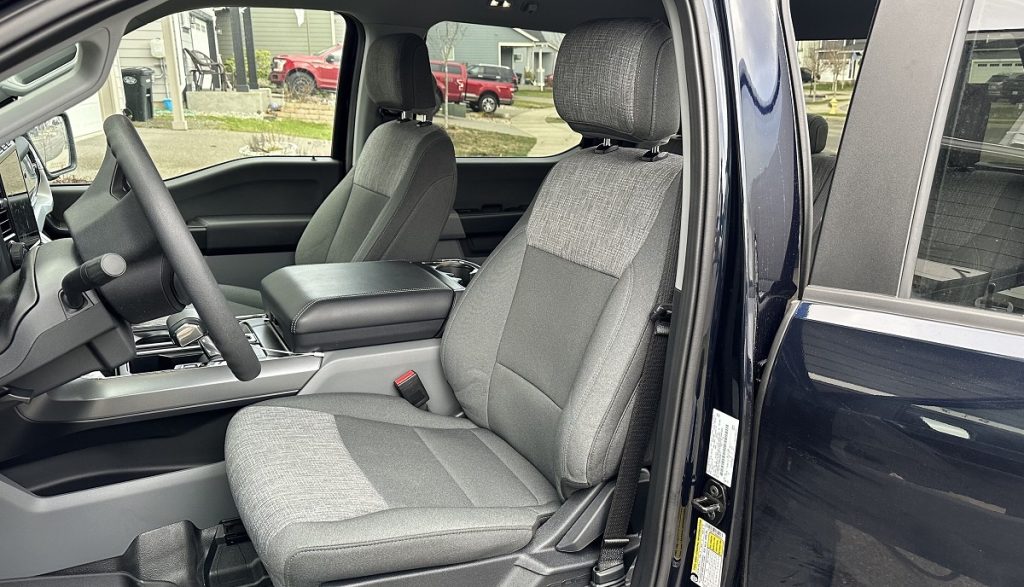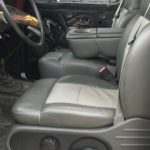When it comes to the Ford truck lineup, the F150 and F250 stand out as top contenders, each boasting its own set of features and capabilities. But amidst the sea of similarities and differences between these two models, a question frequently arises among truck enthusiasts: Are the seats in the F150 and F250 interchangeable? In this comprehensive guide, we’ll delve deep into the intricacies of Ford truck seating to provide you with a clear understanding of this matter.
Understanding Ford F150 and F250 Trucks
Before we dive into the specifics of seat compatibility, it’s essential to grasp the fundamental distinctions between the Ford F150 and F250 trucks.
Ford F150: The Versatile Workhorse
The Ford F150 has long been hailed as America’s favorite pickup truck, renowned for its versatility, reliability, and impressive towing capabilities. As a light-duty truck, the F150 strikes a balance between power and practicality, making it an ideal choice for daily commuting, off-road adventures, and light hauling duties.
Ford F250: The Heavy-Duty Powerhouse
In contrast, the Ford F250 is the epitome of heavy-duty performance, catering to drivers with demanding towing and hauling needs. With its robust construction, formidable engine options, and enhanced payload capacities, the F250 is designed to tackle the toughest jobs with ease. From construction sites to ranches, the F250 excels in scenarios where raw power and durability are paramount.
Exploring Seat Compatibility: Is It Possible to Swap Seats?
Now, let’s address the burning question on every Ford truck owner’s mind: Can you interchange the seats between the F150 and F250 models?
Seat Dimensions: Size Matters
While the seats in both the F150 and F250 may share a similar aesthetic design, there are notable differences in their dimensions. Due to the F250’s heavier-duty nature and larger cabin space, its seats tend to be more substantial and offer additional support compared to those found in the F150. These variations in size and shape can impact the interchangeability of seats between the two models.
Mounting Points: The Key to Compatibility
One crucial factor to consider when contemplating seat swaps is the mounting points within the vehicle’s cabin. The F150 and F250 feature distinct chassis designs and cabin configurations, resulting in differences in the placement and alignment of seat mounting points. As a result, seats designed for one model may not seamlessly fit into the other without modification.
Electronics and Features: Beyond the Basics
In today’s automotive landscape, seats are more than just places to sit—they’re equipped with a plethora of electronic controls and comfort features designed to enhance the driving experience. From power adjustments and heating functions to massage settings and memory presets, modern truck seats offer a level of luxury and convenience that was once reserved for high-end sedans. When considering seat swaps between the F150 and F250, compatibility issues may arise concerning these electronic systems and features. It’s essential to ensure that any replacement seats are compatible with the vehicle’s wiring harness and control modules to avoid functionality issues.
Factors to Consider Before Swapping Seats
Before embarking on a seat-swapping adventure, there are several critical factors to keep in mind to ensure a successful and hassle-free outcome.
Safety First: Prioritizing Passenger Protection
The safety of vehicle occupants should always be the top priority when making modifications to your truck’s seating configuration. It’s essential to verify that any replacement seats meet or exceed the safety standards set forth by regulatory agencies such as the National Highway Traffic Safety Administration (NHTSA) and the Society of Automotive Engineers (SAE). Additionally, ensure that the seat belts, airbag systems, and other safety features remain fully functional and compatible with the new seating arrangement.
Warranty Implications: Understanding the Fine Print
Modifying the seating configuration of your Ford truck could potentially void or impact your vehicle’s warranty coverage. Before proceeding with any seat swaps, it’s advisable to consult the warranty documentation provided by the manufacturer or speak with a knowledgeable representative at your local dealership. They can offer insights into how seat modifications may affect your warranty coverage and provide guidance on navigating any potential issues that may arise.
Professional Installation: Leave It to the Experts
While the allure of a DIY project may be tempting, when it comes to seat swaps, it’s often best to leave the job to the professionals. Experienced mechanics and certified technicians have the expertise, specialized tools, and resources necessary to ensure that the installation is performed correctly and safely. Attempting to tackle a seat swap without the proper knowledge or equipment could result in subpar fitment, electrical issues, or even compromise the structural integrity of the vehicle.
Mastering Seat Compatibility: Expert Tips for F150 and F250 Owners
When it comes to swapping seats between the Ford F150 and F250 models, attention to detail and proper planning are crucial for success. Here are some expert tips to help you navigate the complexities of seat compatibility and achieve the desired outcome seamlessly.
Tip 1: Understand Model-Specific Differences
Before diving into a seat swap project, take the time to familiarize yourself with the specific differences between the F150 and F250 models. Understanding the unique features, dimensions, and configurations of each truck will provide valuable insight into potential compatibility issues and help you make informed decisions throughout the process.
Tip 2: Confirm Compatibility Before Purchasing Seats
To avoid costly mistakes and ensure a smooth installation, always verify the compatibility of replacement seats before making a purchase. Check for any discrepancies in dimensions, mounting points, and electronic features that may affect fitment and functionality. Consulting with a trusted automotive expert or dealership can provide valuable guidance in selecting the right seats for your truck.
Tip 3: Pay Attention to Seat Electronics and Features
Modern truck seats often come equipped with advanced electronic controls and features, such as power adjustments, heating, and ventilation. When swapping seats between the F150 and F250, consider whether the replacement seats have compatible electronics and features to maintain functionality. Failure to address compatibility issues may result in non-functional or malfunctioning seat controls, compromising comfort and convenience.
Tip 4: Prioritize Safety and Compliance
Safety should always be a top priority when modifying your vehicle’s seating configuration. Ensure that any replacement seats meet safety standards and are compatible with your truck’s restraint systems, including seat belts and airbags. Additionally, adhere to all local regulations and guidelines governing vehicle modifications to maintain compliance and minimize risks on the road.
Tip 5: Seek Professional Installation Assistance
While DIY enthusiasts may be tempted to tackle seat swaps on their own, enlisting the help of professional installers is often the safest and most efficient approach. Experienced mechanics and technicians possess the expertise and specialized tools necessary to ensure proper fitment and functionality, reducing the risk of errors or complications during installation. Investing in professional installation services can save time, frustration, and potential headaches down the line.
Tip 6: Preserve Warranty Coverage
Before proceeding with any modifications to your truck’s seating arrangement, review your vehicle’s warranty documentation to understand how seat swaps may impact coverage. Modifying factory-installed components could void or affect your warranty, so it’s essential to weigh the potential consequences and consult with your dealership if necessary. Taking proactive measures to preserve warranty coverage will provide added peace of mind and financial protection in the event of unforeseen issues.
By following these expert tips, F150 and F250 owners can navigate the complexities of seat compatibility with confidence and achieve optimal results. Whether you’re upgrading to premium seats or replacing worn-out ones, careful planning, attention to detail, and professional assistance will ensure a successful and satisfying outcome.
FAQs: Answering Your Burning Questions About F150 and F250 Seat Compatibility
As you embark on the journey of exploring seat compatibility between the Ford F150 and F250 trucks, it’s natural to have questions. Here, we’ve compiled a list of frequently asked questions to provide clarity and insight into this topic. Let’s dive in and address your burning queries.
Q: Can I swap seats between my Ford F150 and F250?
A: While it may be possible to swap seats between the F150 and F250 models, several factors need to be considered, including differences in dimensions, mounting points, and electronic features. It’s crucial to verify compatibility before proceeding with any seat swaps.
Q: Are the seats in the F150 and F250 the same size?
A: While the seats in both models may appear similar in design, there are notable differences in size and shape due to variations in cabin space and overall vehicle dimensions. It’s essential to confirm compatibility and fitment before attempting any seat swaps.
Q: Do I need to modify my truck to swap seats between an F150 and F250?
A: Depending on the specific seats being swapped and the differences between the F150 and F250 models, modifications may be necessary to ensure proper fitment and functionality. Consulting with a qualified technician or dealership can provide valuable guidance on the required modifications.
Q: Will swapping seats affect the warranty on my Ford truck?
A: Modifying your vehicle’s seating configuration could potentially impact your warranty coverage, depending on the extent of the modifications and the policies of the manufacturer. It’s advisable to review your warranty documentation and consult with a dealership representative to understand any potential implications.
Q: Can I install aftermarket seats in my Ford F150 or F250?
A: Yes, aftermarket seats are available for both the F150 and F250 models, offering a wide range of customization options in terms of design, materials, and features. However, it’s essential to ensure that any aftermarket seats are compatible with your truck’s mounting points and safety systems to maintain functionality and compliance with regulations.
Q: How can I ensure a successful seat swap between my F150 and F250?
A: To ensure a successful seat swap, it’s crucial to verify compatibility, consider any necessary modifications, prioritize safety and compliance, and seek professional installation assistance if needed. By taking these factors into account, you can achieve optimal results and enjoy enhanced comfort and functionality in your Ford truck.
Conclusion: Navigating the World of Ford Truck Seats
In conclusion, the question of whether F150 and F250 seats are the same is more complex than it may initially seem. While both models may share certain design elements and components, significant differences in dimensions, mounting points, and electronic features can impact their interchangeability. Before embarking on a seat-swapping endeavor, it’s crucial to carefully consider the factors outlined in this guide, including safety considerations, warranty implications, and the importance of professional installation.
So, are F150 and F250 seats truly the same? The answer is nuanced, with compatibility depending on a variety of factors. By understanding these distinctions and taking the necessary precautions, you can make informed decisions about seat swaps while ensuring the safety, comfort, and functionality of your Ford truck for years to come.


